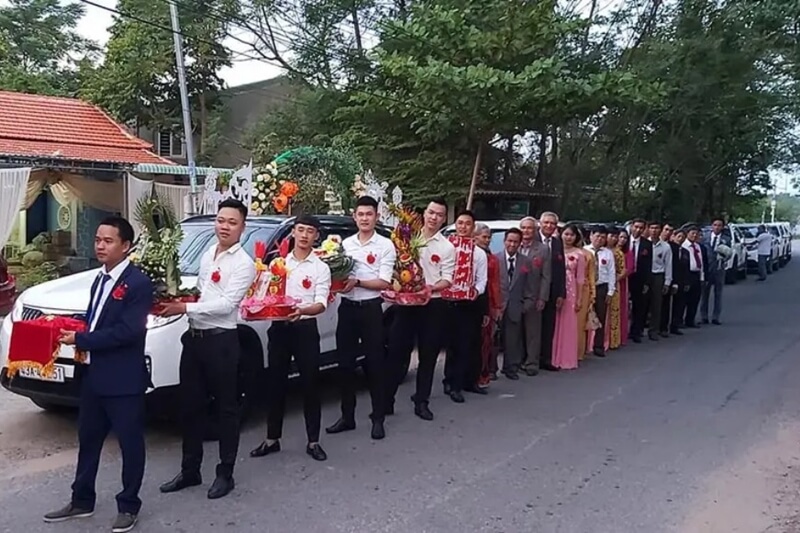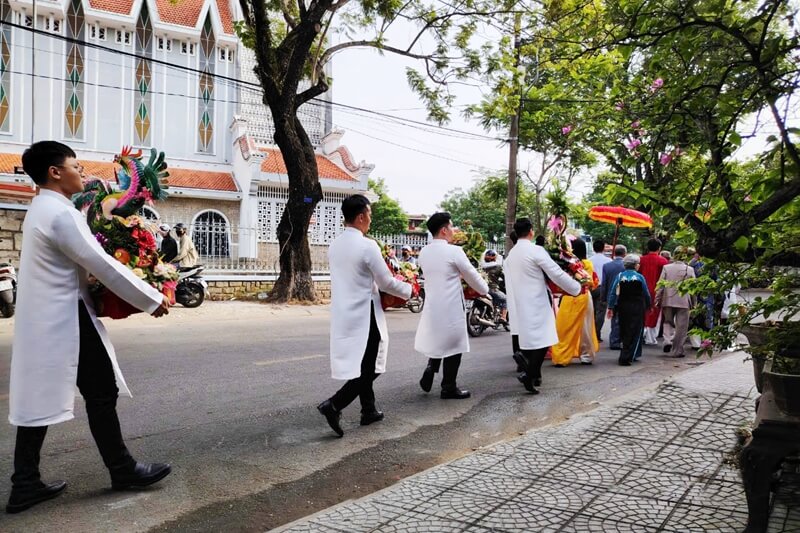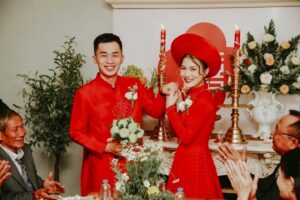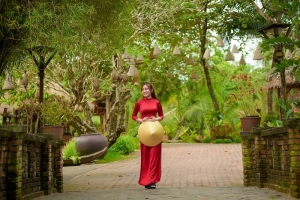The development of society has modernized traditional styles, yet the core of culture remains with the local people. In Vietnamese weddings, despite some changes, the conventional ceremony still consists of four significant steps:
- Meeting ceremony (Lễ giạm ngõ)
- Engagement ceremony (Lễ ăn hỏi)
- Marriage ceremony (Lễ cưới)
- Reunion ceremony (Lễ lại mặt)
Let’s go deeper!
1. Meeting ceremony
The ceremony is the first official meeting between the two families, creating the first step to starting the traditional Vietnamese wedding.
During this event, the boy’s family goes to the girl’s house to ask permission for the couple to officially and publicly learn each other before deciding to get married.
This ceremony is just a cultural behavior through which two families better understand each other’s backgrounds.
Following traditional Vietnamese culture, the presents for this activity are very simple: only betel and areca. Some places in Vietnam allow you to carry a couple of tea bags and wine bottles.
Because some families live far away, this ceremony can be ignored. But, without it, it can cause a sudden thing, typically for the girl’s family, so they cannot have enough time to prepare the spirit to organize the wedding.
Although the meeting ceremony is unimportant, it is a good trigger for marriage.
Also, a plus point for this tradition is that offering gifts, only betel and areca, or a couple of tea bags and wine bottles, is inexpensive. But it still shows the national cultural identity.
2. Engagement ceremony
According to Vietnamese wedding customs in the past and now, this step is a vivid action because it officially announces the marriage promise between the two families. The engagement ceremony also happens in the girl’s house.
This stage gets to a new level in the couple’s marriage: the boy and girl become fiancé. The boy has been approved and accepted by the future parents-in-law as a son-in-law.
What does the boy’s family need to prepare for the engagement ceremony?
- Select the clothes for the groom that are different from uniform outfits for those who follow to visit the female family.
- Choose a few young boys wearing uniforms with fresh appearance, younger than or equal to the groom’s age, and they are still single.
- Engagement ring: In traditional culture, this time is when the boy gives the girl an engagement ring.
- Gifts to ask for a wedding ceremony: In Vietnamese culture, the engagement ceremony is indispensable for betel and areca, especially for couples of wife-husband cakes. The required number of presents must be an even number (a multiple of 2 representing the couple).
What does the girl’s family need to prepare for the engagement ceremony?
- Have the Vietnamese wedding dress for the girl, usually a traditional long dress – Ao Dai, and the traditional clothes for people who welcome the boy’s family.
- Clean the house and decorate the ancestors’ altar with flower vases, fruit, and cake.
- Decorate the space to hold the engagement ceremony, and set up a canvas with the name of the bride and groom as a place to take souvenir photos.
- Prepare the party to serve the boy’s family and relatives, which depends on the condition of the female family.
3. Marriage ceremony
The marriage ceremony plays the most crucial role in weddings in Vietnam.
This activity officially allows the boy and girl to live together in the same house, room, and bed.
The process of “Lễ cưới” can be a little different from the regions and religions in Vietnam.
In general, it includes the Xin dâu (Ask for a bride), Rước dâu (Welcome the bride), and wedding party.
3.1. Ask for a bride (Xin dâu)
Starting with the ask-for-a-bride ceremony, the male family sends a person, usually the groom’s mother or uncle, to the female wedding.
That person brings wine bottles and betels to ask to welcome her, and the bridegroom group will come.
This step can be ignored with the allowance and discussion of two families when they stay too far away.
However, it still happens when combined with the activity of the next step of Rước dâu.
3.2. Welcome the bride (Rước dâu)
This step is the most essential in the process of a Vietnamese wedding.
When the bridegroom’s family comes near the bride’s house, they will stop to fix the clothes.
- The representative usually leads the group to pick up the bride’s family, followed by the groom’s father, relatives, and friends. The group can have more or fewer members depending on the agreement in advance. However, not many people will make welcoming the bride more convenient and comfortable.
- The bride’s family will stand in front to welcome the groom’s family to the house. After the two families have their sitting positions, a representative will introduce the members of each side while they have a hot cup of tea.
- After that, the representative of the groom’s family will say a few words and formally ask for the allowance to welcome the bride to the male family.
- Having received permission from the bride’s family, the bride’s mother will hand the girl to the groom. Then, the couple will come to the ancestral altar and perform ancestral reporting rites.
- After the Xin dâu ceremony, the groom’s family welcomes the bride home. The bride’s family will accompany the groom’s family to the male house. Then, they will continue organizing the following rites.
- In the groom’s home, the parents first lead the bride and groom to the ancestral altar. Then, they burn incense and report to their ancestors about the critical events of their life, becoming husband and wife.
- After the ceremony, the party is opened to welcome the bride’s family and relatives.
Those are the essential rites performed at a traditional Vietnamese wedding.
Nowadays, all activities are simplified to the maximum comfort so couples can organize their wedding more easily and quickly.
Ensure the meaning of traditional culture, with all necessary rituals, but not too fussy, costly time, cost, and effort.
3.3. Wedding party
In the past, there were no economic conditions or modern facilities. The wedding party will be held at home.
Currently, most families turn to wed centers to ensure the bride and groom have significant life events without worrying too much about the preparation and services.
So, all relatives and friends are invited to restaurants to enjoy the wedding party. Usually, the meals include five food dishes, live music, and beers.
A small wedding in Vietnam typically has around 150 guests, while larger weddings can have 250 guests or more. Surprisingly, some weddings may even have over 800 guests.
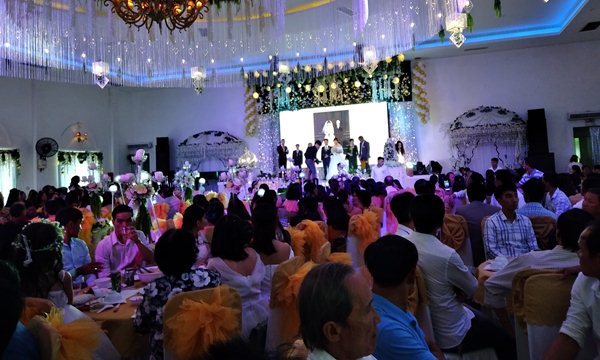
When joining the wedding party, relatives and friends give gifts to the new couple.
In the past, they could present money, gold, pictures, or any tools for use in the family.
Nowadays, to avoid buying unnecessary things, they give money or gold to the bride and bridegroom. This gift can help them have a small property to start their new life.
4. Reunion ceremony
Another ceremony considered the final step of a Vietnamese wedding is the reunion ceremony, called Lễ Lại Mặt or Lễ Nhị Hỷ in Vietnamese.
This ceremony means that the newlyweds will return to visit the bride’s family after the wedding.
To welcome the children, the parents-in-law will prepare a friendly meal to invite their son-in-law, mainly an intimate dinner for the family.
Usually, this ritual takes 1 – 3 days after the wedding. However, the specific time is flexible based on the actual situation, work, and geographic location between the two families to get the best adjustment.
The purpose of the reunion ceremony is to express the son-in-law’s respect and gratitude for his wife’s parents’ work and nurturing.
At the same time, understanding the psychology that after coming to the husband’s house, the new bride will have many surprises, causing the mentality of sadness and attachment to her biological parents.
So, the reunion family ceremony is a traditional custom that encourages the bride’s spirit in married life.
A traditional Vietnamese wedding has four essential steps above. However, each area in Vietnam can have different ways to organize a wedding.
Learning traditional wedding rituals can help new couples have perfect weddings following the beautiful culture, creating a cozy ceremony full of necessary activities. All have a memorable anniversary in their life.

